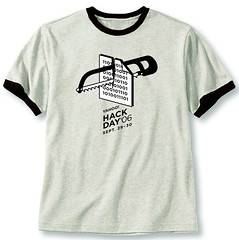After observing several Hack Day presentations and conducting a few screencasts of my own now, I think I’m seeing a formula for doing a 90-second demo.
 |
No format will replace charisma. And charisma won’t make a bad demo good. But these guidelines might at least give the presenter a baseline. And I’m sure this will help people who are competing at Hack Day.
People can usually articulate more than two words per second without sounding like one of the Kingsmen, but that doesn’t leave any room for dramatic pauses or potential hiccups in the presentation. So, a good 90-second demo will probably come out to maybe 150 words.
What can you communicate in 150 words? Not much.
The meat of the demo obviously must consist of a walk-through, but it’s often the beginning and end that screw up the whole thing.
The most common mistake is a poorly balanced intro that either drags on too long and makes the audience anxious or one that is too short and forces the audience to contextualize things in their own heads when they should be following what you’re saying.
Spend little or no time introducing yourself. Save that for the end. But spend 20 seconds defining the problem. Answer these questions:
- What’s wrong or broken?
- How do people deal with this problem today?
Then get to the meat. Step the audience through a story one click at a time. Show a screen. Explain what is being shown. And then describe what will happen next. Tell them where you plan to click or what action you’re going to take and then do it. Explain the result and then repeat, one action at a time.
If at all possible, build the story to a climax. Each step from click to click should get progressively more interesting. At least point out the less dramatic elements of the demo first and build to the most exciting ones at the end. At about 80 seconds, you want to reveal the POW that will get everyone clapping.
If you get your POW before 80 seconds, great. Crack a joke and get off the stage. Don’t drag it out if you’re already done.
If all goes well, eyes will light up and cheers will wash over you.
Finally, close with some kind of contact information. Announce your name and the name of your demo during the applause, and leave before the applause finishes.
Here are a few hints that might also help:
- Script it. Write out what you plan to say. It will take you about 10 minutes, and then have someone read it out to you so you can hear it for yourself.
- It’s never a waste of time to deliver a one-liner that will get laughs. If you have something funny to say, say it, without hesitation. Humor wins fans universally and buys you a fully engaged audience.
- The result of working code is often what presenters are most proud of, and there’s a tendency to go from intro to result too quickly. The audience wants to get inside your head and follow your thought process. If there isn’t an actual clickable demo to show, then walk the audience through a couple of visual diagrams that show what is happening behind the scenes.
- Make it big. The demo screen is never big enough, so change your screen resolution to be as big as possible without completely distorting the demo.
- Point to things on the screen with your finger. Don’t assume people are following your mouse. Stand in front of the screen and reach with your finger to show them what you’re talking about.
- Use dramatic imagery even if it isn’t technically correct or specifically relevant. Particularly when getting mixed in amongst a bunch of other demos, you want to burn a visual image into people’s memories. Nobody will remember a word you said, but they will all remember what it looked like.
- If your demo fails, don’t sweat it. It happens all the time. Be gracious and tell your audience how they can reach you to talk about your idea and perhaps see a demo later.
- Don’t pretend like a failing demo is going to come back “any second now”. Demo audiences are forgiving, but they’re rarely patient.
There are lots of common public speaking tactics to take with you on stage, too, but I would never proclaim to be an expert in that.
Those who can’t do, teach.
Lastly, here are some interesting resources on presenting:
- How To Get A Standing Ovation, Guy Kawasaki
- Behind The Magic Curtain (Doing demos with Steve Jobs), Mike Evangelist
- 10 Tips for Successful Public Speaking, Toastmasters.org
- Presentation Zen blog, Garr Reynolds
- Wikipedia: Public Speaking
Doh! I screwed up in so many places in June. These 90 second demos could be so much more though – they could become the meat of a job interview ( see http://richarddcrowley.org/blog/130/ ).
There’s another aspect of demos that people sometimes forget. You often don’t have to demo what you’re doing live.
Make sure it works, but it never hurts to have a precanned result cached and raring to go (just don’t make it TOO obvious and have powerpoint transitions).
Hey, nice tips! Much of this could also apply to many presentations of various lengths. Seems to me there are many bad presentations for every good one in most venues.